freeze-drying - ALD Vacuum Technologies
freeze-drying - ALD Vacuum Technologies
freeze-drying - ALD Vacuum Technologies
- No tags were found...
You also want an ePaper? Increase the reach of your titles
YUMPU automatically turns print PDFs into web optimized ePapers that Google loves.
<strong>Vacuum</strong> FREEZE-DRYING■ Industrial Production Plants with Daily Throughputs Rangingfrom 500 kg to 60 tons of Fresh Product per Unit
Industrial Freeze-DryingFREEZEDRYING67Freeze-<strong>drying</strong> is used to preserve productscontaining water or solvents. Good preservationof fragrances, flavorings and ingredientswith nutritional value is crucial in thefoodstuff industry. With proper packagingand storage, <strong>freeze</strong>-dried products can bestored for a very long time without anyappreciable loss of quality even at roomtemperature. Weight reduction will be up to92%. Owing to their extremely large internalsurface area, <strong>freeze</strong>-dried products havean optimal capacity to take up water again(reconstitution, rehydration). <strong>ALD</strong> industrial<strong>freeze</strong>-<strong>drying</strong> systems offer the best capabilitieswith respect to performance, versatilityand product quality and lower heatingtemperatures by contact heating, hence alower final temperature of the product andbetter flavor retention. Further-more theyhave more sublimation power per m 2 ofarea.The main application for <strong>freeze</strong>-<strong>drying</strong> resultsfrom the remarkable advantages of the finalproduct with respect to the conservation ofvolatile aromatics, heat-sensitive ingredients,color, taste, original shape, texture and nutritionalvalue, as well as quick rehydrationbefore use.Phase diagram for waterStandard <strong>freeze</strong>-<strong>drying</strong> tunnel sectionApplications of Freeze-Drying:■ Instant coffee and tea;■ Drying of meat and meat products,poultry, fish and shellfish, fruitsand vegetables;■ Dairy products such as starter culturesfor yogurt and cheese production;■ Freeze-<strong>drying</strong> of coloring pigments;■ Production of starting materials havinglittle agglomeration for use in themanufacture of complex sinteredceramic materials.
FREEZEDRYING68The Principles ofFreeze-DryingAt atmospheric pressure (approx. 1,000mbar) water can have three physical states■ Solid;■ Liquid;■ Gaseous.Below the triple-point (for pure water:6.1 mbar at 0°C), only the solid andthe gaseous states exist.The principle of <strong>freeze</strong>/sublimation-<strong>drying</strong>is based on this physical fact. The ice inthe product is directly converted into watervapor (without passing through the “fluidstate”) if the ambient partial water vaporpressure is lower than the partial pressureof the ice at its relevant temperature.The <strong>freeze</strong>-<strong>drying</strong> process is divided intotwo different physical process steps. Stepone is the freezing of the material below itssolidification temperature and step tworemoves the ice or solvent crystals at verylow temperatures.The Freezing ProcessThe freezing process has a great influenceon the quality of the finished product andthe time that will be required to dry thematerial.For continuously operating <strong>freeze</strong>-<strong>drying</strong>installations with high throughputs the mostfamilar freezing systems will be continuousblast air freezing belts. In addition, fluidisedbed systems, freezing channels or chamberswill be used.Continuous <strong>freeze</strong>-<strong>drying</strong> system with up to 60 tons of fresh product per day per unit
FREEZEDRYING69For freezing of liquids, especially coffeeextract, automatic freezing belts are used.Different temperature zones, variable velocityof the belt and adjustable thickness ofthe product layer permit optimized freezingconditions adapted to the requirements ofthe different products.GranulationFrozen liquids, especially coffee extract, aregranulated and classified to the desiredgranule sizes in a cold room at very lowambient temperatures. The frozen granulesare collected in a buffer store and then fedinto special <strong>drying</strong> trays by an automaticfilling device.Freeze-DryingThe <strong>drying</strong> process is carried out in avacuum chamber at pressures that arelower than the water vapour pressure ofthe frozen products at their solidificationtemperature. The necessary heat to effectand accelerate sublimation is suppliedfrom an external source.zones. The entry and exit operation is realizedby vacuum lock systems enabling thecontinuous operation of <strong>freeze</strong>-<strong>drying</strong>.In addition to the known <strong>freeze</strong>-<strong>drying</strong>method with trays (static <strong>freeze</strong>-<strong>drying</strong>) <strong>ALD</strong>offers so-called “Dynamic Freeze-DryingInstallations”. This <strong>drying</strong> method is usedfor fluid/free-flowing products. In this“trayless systems”, the products are indirect contact with the heating surface. Thefrozen and granulated product is broughtinto the sublimation/<strong>drying</strong> tunnel by aspecial lock device.Inside the <strong>drying</strong> tunnel, the product is uniformlydistributed by a special distributiondevice to the first belt of the belt transportsystem. A thin product layer and someintermix/turn-around of the product permitsSchematic of the belt system for dynamic <strong>freeze</strong>-<strong>drying</strong>The <strong>ALD</strong> delivery program comprises largeindustrial production plants with throughputsranging from 500 kg to 60 tons offresh product per day and plants incontinuous and discontinuous operation.In static <strong>freeze</strong>-<strong>drying</strong>, carriers with thefilled <strong>drying</strong> trays are transported into the<strong>freeze</strong>-<strong>drying</strong> tunnel. During the <strong>drying</strong> process,the carriers with the <strong>drying</strong> trays moveautomatically through different temperature
FREEZEDRYING71Refrigeration PlantIn industrial <strong>freeze</strong>-<strong>drying</strong> installations, greatrefrigeration capacities must be achievedat low evaporation temperatures of lessthan minus 40 °C down to minus 60 °C.Ammonia absorption installations and compressor-typeinstallations may be used forthe generation of the necessary refrigerationcapacity. The final/adequate choice ofthe refrigeration system depends on variousfactors such as cost of electrical energyand heavy oil, process, operation andproduct parameters.Processing Lines<strong>Vacuum</strong> pump system of a continuous <strong>freeze</strong><strong>drying</strong>plant<strong>ALD</strong> <strong>Vacuum</strong> <strong>Technologies</strong> AG can alsodesign, engineer and construct completeprocessing lines for pre- and post-processtreatment of products like <strong>freeze</strong>-driedcoffee, fruits and vegetables, etc.Installation of an <strong>ALD</strong> industrial <strong>freeze</strong>-<strong>drying</strong> unit



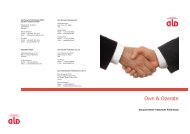
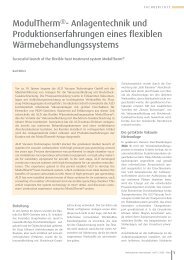
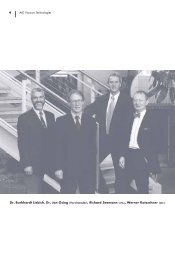
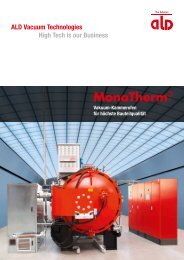
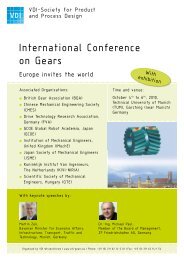
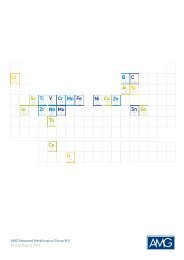
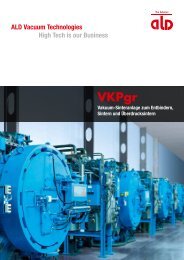

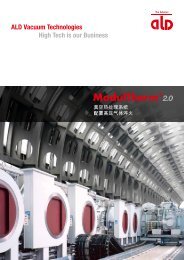
![TITANIUM brochure [PDF] - ALD Vacuum Technologies](https://img.yumpu.com/30889132/1/184x260/titanium-brochure-pdf-ald-vacuum-technologies.jpg?quality=85)

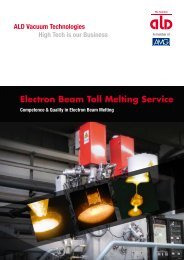
![(VID) Technology brochure [PDF] - ALD Vacuum Technologies](https://img.yumpu.com/30095121/1/184x260/vid-technology-brochure-pdf-ald-vacuum-technologies.jpg?quality=85)
